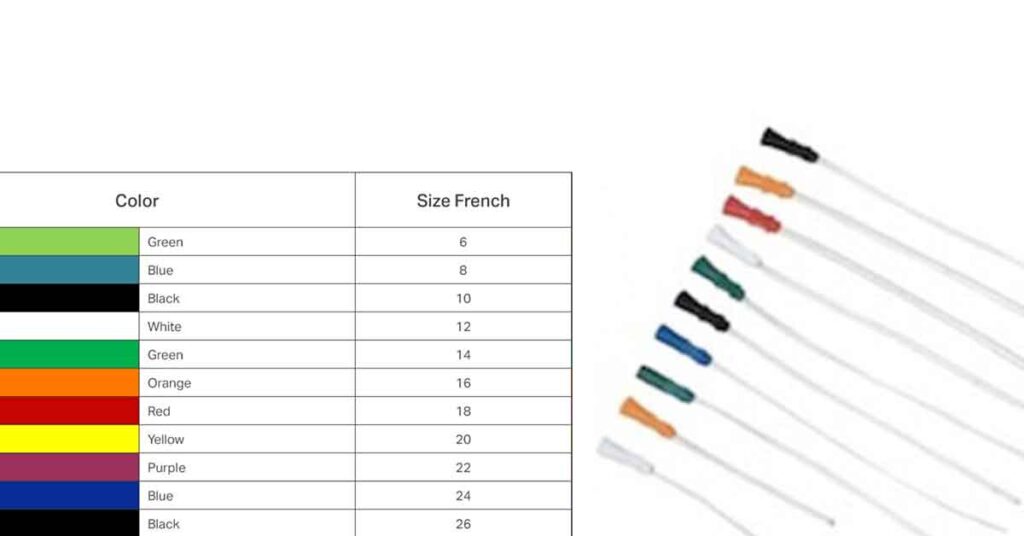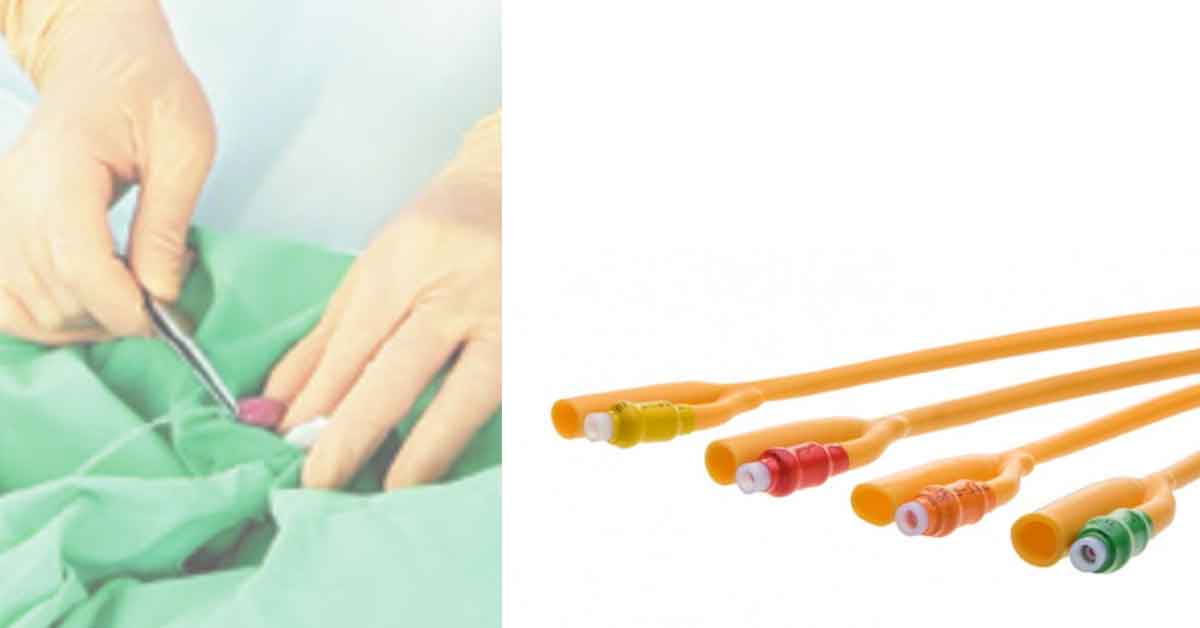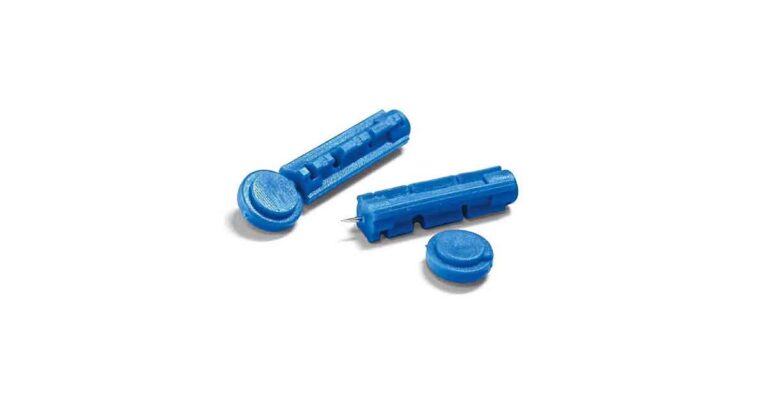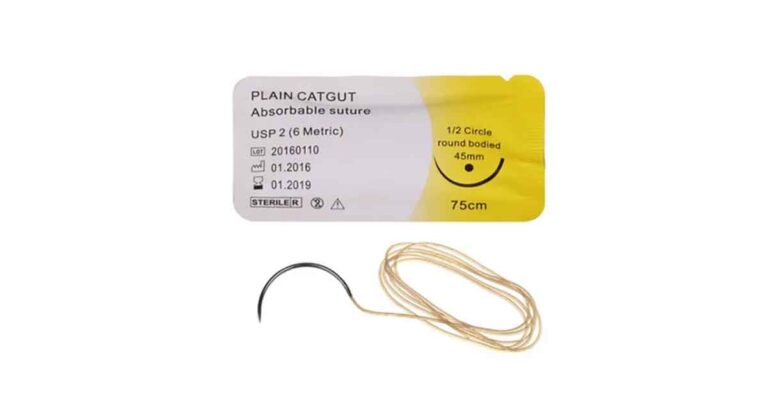A urinary catheter is a thin flexible hollow tube used to empty the bladder and collect the urine in a drainage bag (urine bag). The material of the catheter is mostly made of coated latex or silicone.
Different polymer coatings has been used recently as it reduces friction by employing hydrogel. The hydrogel provides hydrophilic slippery surface, while antimicrobial agents like silver helps to reduce urinary tract infections risks.
The insertion of catheter is done by a qualified medical personnel (doctor or nurse). It is inserted through a tube that carries the urine out of the bladder (urethral catheter) or through a small opening in the lower abdomen (suprapubic catheter). Once inserted, the small balloon remained inflated to prevent the catheter from falling out.
The catheter can be used for a long term or removed after hours or days. Indwelling catheters are mostly used for few weeks when continuous drainage is needed, but can also be used for long term.
Catheterization can be a painful and uncomfortable procedure hence the use of anesthetic gel like lidocaine jelly.
When Urinary Catheters are used:
Before we explain the need for catheterization, we have to understand the anatomy of the urinary tract.
The upper urinary tract is made of kidney and the ureters, while the bladder and urethra makes up the lower urinary tract. The bladder is the temporal storage organ for the urine as it passes out of the body through the urethra. Urine is made of soluble waste products filtered by the kidneys from the bloodstream
Urine output per day is 1500 ml but the bladder can only hold a urine capacity of 300 – 500 ml. Since the bladder has limited capacity, it removes the urine content intermittently for about 6 to 10 times in a day. The cyclical filling and emptying of the bladder is a coordinated activity between the bladder and urethra. The bladder relax to allow the urine inflow, while the urethra contract to prevent leakage, and vice versa when bladder empties.
This activity is controlled by a nerve network passing between bladder and brain via the spinal cord ensuring the bladder empties completely at each voiding, and at the right time.
Some diseases can cause obstruction of the normal urine flow leading to conditions like urinary incontinence or retention. In such situations, urinary catheter could become vital.
Urinary Catheters are Used In:
- Obstruction of the urethra due to scarring or prostate enlargement blocking the flow of urine out of the bladder.
- To rest the bladder after episode of urinary retention
- Drain the bladder before or after a surgery especially after bowel, bladder, or urinary tract surgery
- To deliver medications directly to the bladder like during chemotherapy for bladder cancer.
- To drain the bladder during childbirth in case the person has an epidural anesthetic.
- In those with nerve damage and bladder weakness preventing the normal flow of urine.
- Monitoring renal function
- Collection of sterile urine sample.
Long Term Uses of Urinary Catheters:
Urinary catheter are not recommended for long term due to the risks of catheter-associated urinary tract infection. But as a last resort, long-term drainage of the bladder with urinary catheter is used for patients with diseases that prevent normal drainage of the bladder like:
- For conditions like spinal injury, stroke, multiple sclerosis, and diabetes complications
- Intractable urinary incontinence when other treatment options failed
- Chronic debilitating illnesses
- Those unfit for surgery
Types of Urinary Catheters
There are two main types of urinary catheters: the intermittent and indwelling catheters. The method of insertion of both of them are similar, except that the indwelling catheter need a closed drainage system, and the inflation of the balloon to keep the catheter in place.
Intermittent catheters
The Intermittent catheter also called single-lumen catheter, is temporarily inserted into the bladder through the urethra and removed after emptying the bladder. They are the most common types of urinary catheters. It is softer and more flexible than the indwelling catheter as it is made of rubber or polyvinyl chloride (PVC).
Intermittent catheters can be inserted many tines a day and removed after draining the bladder. They are used once and discarded.
It is mostly pre-lubricated to reduce pain and discomfort during insertion. One end is left open-ended to allow urine drainage or attached to a urine bag to collect the urine. The other end is guided into the urethra to enter the bladder and allow urine inflow.
Main uses of intermittent catheters are for managing urinary retention, obtaining a sterile urine sample, long-term management of incompetent bladder.
Indwelling catheters
Indwelling catheters are also called Foley catheters are semi-rigid, flexible tubes. It can be double- or triple-lumen (three-way) catheter. It was designed by Frederic Foley, a surgeon working in Boston, Massachusetts in 1937. The double lumen has one lumen for urine drainage, and the second lumen to keep the catheter in position by inflating the balloon.
The triple lumen catheter has an additional lumen that delivers irrigation fluid into the bladder. This type is used for continuous bladder irrigation and to instil medications into the bladder.
The indwelling catheters are held in place by inflated water filled balloon in the bladder to prevent it from falling out. It is meant to stay for days or weeks.
They may have a valve that can be closed to allow the bladder to fill with urine and opened to drain it.
Indwelling catheters are used to improve elimination of urine, assess abdominal/pelvic pain, measure urine output, prevent skin breakdown, wound management, surgical repair of urethra, bladder, or surrounding structures, and to instill irrigation fluids or medications.
Since they remain in place for a long time, they are more convenient than intermittent catheters. However, they are more likely to cause infection.
Indwelling catheters are made of latex or silicone. There are also two types of indwelling catheters: urethral and suprapubic catheters. The insertion of the urethral indwelling catheter is through the urethra into the bladder, while a suprapubic catheter is inserted through an incision on the abdominal wall into the bladder.
Suprapubic catheters
This type of catheter is inserted through a hole in the abdomen and then into the bladder. It is meant to stay for a long time and changed after 6 to 8 weeks. It is used when the urethra is damaged and done under epidural, general or local anesthetic.
The catheter can be secured to the side of the body and attached to the drainage bag strapped to the leg. A valve that closes to allow the bladder to fill with urine and opens to drain out the urine can also be attached.
External Catheters
External Catheter, also called condom catheter is a flexible sheath, that slides over the penis just as condom. It has a tube connected to a bag, and is only available for men. It is used to manage urinary incontinence, and not urinary retention.
Choosing the Right Intermittent and Foley Catheter Sizes
Intermittent catheters are available in different sizes to accommodate differences in anatomical differences, body function and medical needs of different patients. The sizes of the catheter are related to the thickness or diameter of the catheter, and are measured in Charriere (Ch) or French Gauge (FG). The French size is used only for the intermittent and indwelling (Foley) catheters.
The “French” or “FR” is not related to the length of the catheter, but comparable to the circumference of the catheter in millimeters (“FR” is equivalent to 0.33 millimeters, or 0.013 inch or 1/77 inch in diameter).
The 2009 Guideline for Prevention of Catheter-Associated Urinary Tract Infections (CAUTI), the Centers for Disease Control (CDC) advocated for the use of catheter with the smallest possible diameter to achieve good drainage and prevent bladder and urethral trauma associated with the large diameter (or French size).
Catheter Sizes Used by Different Age Groups include:
Generally, they use 5-6 Fr for babies, children use 8 Fr, 10 Fr, or 12 Fr, and teens and adults use 12-20 Fr catheters.
14 Fr to 16 Fr: Adult men, with 14FR commonly used. Men have a longer urethra and use a catheter length of 15-18 inches.
Women (12FR to 16FR): Adult women, with 12FR used mostly. Anatomically, women have shorter urethra, and use shorter catheter. The average length size is 7-10 inches. However, women with reduced mobility or a stoma can use a male-length catheter.
6FR and 10FR: Pediatrics. The average length of the catheter is 11-13 inches.
In adults, it is recommended that we use:
- 12FR –14FR when draining clear urine
- 14FR–16FR for urine with particles or debris
- 18FR and above when there is blood clot in the urine
Urinary Catheter Color Codes
Most intermittent catheters have color-coded funnels which is the French size: The color codes include:
- 6 Fr: Green
- 8 Fr: Blue
- 10 Fr: Black
- 12 Fr: White
- 14 Fr: Green
- 16 Fr: Orange
- 18 Fr: Red
- 20 Fr: Yellow
- 22 Fr: Purple
- 24 Fr: Blue
- 26 Fr: Black

How to Insert the Catheter
Before inserting then catheter, gather the materials required such as sterile gloves, lubricant, cleaning solution, urinary drainage bag, Foley catheter, catheterization kit, and prefilled syringe for balloon inflation.
Watch the video for the full procedure on how to insert the catheter in men and women.
Problems and Issues with the Urinary Catheters
Urinary catheters can cause urinary tract infection to the bladder, urethra and less commonly to the kidneys. This infection called catheter-associated urinary tract infections (CAUTI), can cause increased hospital stay, and morbidity.
The infection could result from both short-term and long-term use, but more prone in long usage. Symptoms of catheter-associated urinary tract infections include back or flank pain, fever, chills, hematuria, lethargy, painful urination, frequent urination, high temperature, confusion, cold, pain in the groin and lower abdomen, change in mental status especially in older patients. This could be resolved with good antibiotics.
To prevent infections (UTIs) from urinary catheter use:
- Wash the hands with warm water and soap when handling the equipment.
- Use water and soap to wash the area of skin around the urinary catheter at least twice daily.
- Stay hydrated by drinking enough fluid therefore keeping the urine pale
- Stay hydrated and eat high fiber food to prevent constipation.
- Use the narrowest possible tube gauge
- Prevent urethral damage by securing the catheter tube
- Make sure the drainage system is closed
- Use indwelling catheter only when necessary, and remove as soon as possible.
- Make sure the urinary catheter has no kinks and the urine bag are below the bladder always.
Other problems with the use include bladder spasm, leakage, blockage, and damage to urethra.
Precaution while using Urinary Catheter
- Remove the urinary catheter only when the balloon is fully deflected
- Adequate lighting and visualization is required when inserting the urinary catheter.
- The supine lithotomy position is deeply uncomfortable and dangerous in some women especially. This position cause decrease in blood flow to the fetus especially in patients in the third trimester of the pregnancy. This position is also discomforting in patients with arthritis of the knees and hips. Rather use the lateral to Sims position (three-quarters prone) method for catheterization in such patients.
References
- https://www2.hse.ie/conditions/urinary-catheter/types/
- https://www.healthywa.wa.gov.au/Articles/U_Z/What-is-a-catheter
- https://www.bladderandbowel.org/bladder/catheter/what-is-a-catheter/https://www.liberatormedical.com/catheters/catheter-tips-and-guides/intermittent-catheter-sizing-guide/
- https://opentextbc.ca/clinicalskills/chapter/10-3-urinary-catheters/












